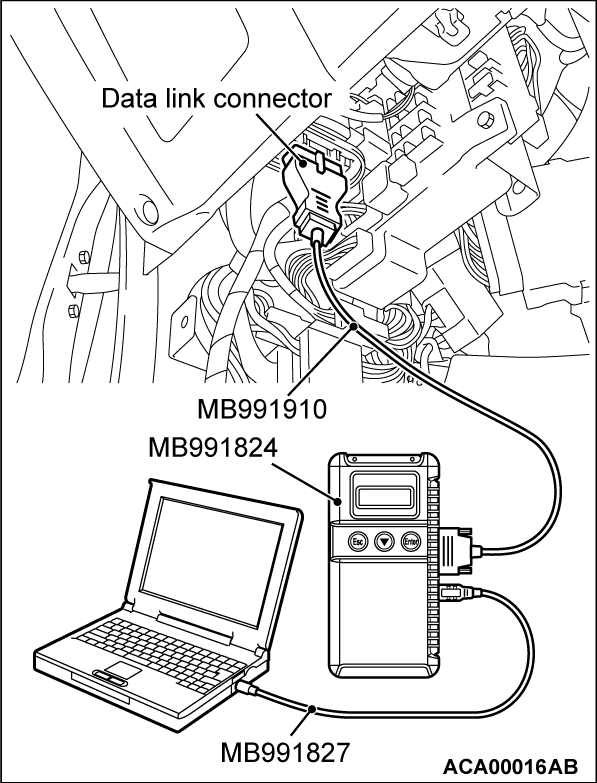Inspection procedure 14: Hesitation, sag, stumble, poor acceleration or surge
COMMENT
- Defective ignition system, abnormal air/fuel ratio, poor compression pressure, etc. are suspected.
TROUBLESHOOTING HINTS (The most likely causes for this case:)
- Fuel pump system failed.
- Ignition system failed.
- Poor compression.
- EGR system failed.
- Improper operation of the PCV valve.
- Vacuum leak.
- Clogged air cleaner.
- Clogged exhaust system.
- CVT system failed.
- ECM failed.
DIAGNOSIS
Required Special Tool:
- MB991958: Scan Tool (M.U.T.-III Sub Assembly)
- MB991824: V.C.I.
- MB991827: USB Cable
- MB991910: Main Harness A
| note | To protect the CVT, the TCM outputs, into the ECM, the request signal to reduce the engine torque according to the operation condition. Based on the signal, the ECM closes the throttle valve, retards the ignition or carries out fuel cut. At that time, the engine output seems to temporarily reduce, but there is no malfunction. |
STEP 1. Check if the EGR valve sounds during initialization.
Is the initialization sound heard in the EGR valve?
STEP 2. Using scan tool MB991958, read the diagnostic trouble code (DTC).
| caution | To prevent damage to scan tool MB991958, always turn the ignition switch to the "LOCK" (OFF) position before connecting or disconnecting scan tool MB991958. |
(1) Connect scan tool MB991958 to the data link connector.
(2) Turn the ignition switch to the "ON" position.
(3) Read the DTC.
(4) Turn the ignition switch to the "LOCK" (OFF) position.
Is any DTC set?
STEP 3. Using scan tool MB991958, read the diagnostic trouble code (DTC).
| note | When the CVT has a malfunction, the TCM might output the request signal of reducing the engine torque in order to protect the CVT. |
(1) Turn the ignition switch to the "ON" position.
(2) Read the TCM-DTC.
(3) Turn the ignition switch to the "LOCK" (OFF) position.
Is the TCM-DTC set?
STEP 4. Using scan tool MB991958, check actuator test.
(1) Turn the ignition switch to the "ON" position.
(2) Check the following item in the actuator test. Refer to Actuator Test Reference Table  .
.
 .
.- Item 1: Injectors
(3) Turn the ignition switch to the "LOCK" (OFF) position.
Are thy operating properly?
 Repair or replace it. Then confirm that the malfunction symptom is eliminated.
Repair or replace it. Then confirm that the malfunction symptom is eliminated.STEP 5. Check the ignition timing.
Is the ignition timing normal?
 Check for installed conditions of the timing chain. Then confirm that the malfunction symptom is eliminated.
Check for installed conditions of the timing chain. Then confirm that the malfunction symptom is eliminated.STEP 6. Using scan tool MB991958, check data list.
(1) Turn the ignition switch to the "ON" position.
(2) Check the following items in the data list. Refer to Data List Reference Table  .
.
 .
.- Item 5: Intake Air Temperature Sensor
- Item 6: Engine Coolant Temperature Sensor
- Item 11: Accelerator Pedal Position Sensor (main)
- Item 12: Accelerator Pedal Position Sensor (sub)
- Item 13: Throttle Position Sensor (main)
- Item 15: Throttle Position Sensor (sub)
(3) Turn the ignition switch to the "LOCK" (OFF) position.
Are they operating properly?
 Repair or replace it. Then confirm that the malfunction symptom is eliminated.
Repair or replace it. Then confirm that the malfunction symptom is eliminated.STEP 7. Check the fuel pressure.
Refer to, Fuel Pressure Test  .
. Repair it. Then confirm that the malfunction symptom is eliminated.
Repair it. Then confirm that the malfunction symptom is eliminated.
 .
.Is the fuel pressure normal?
 Repair it. Then confirm that the malfunction symptom is eliminated.
Repair it. Then confirm that the malfunction symptom is eliminated.STEP 8. Check the spark plugs.
Refer to GROUP 16, Ignition System - On-vehicle Service - Spark Plug Check and Cleaning  .
. Replace the spark plug. Then confirm that the malfunction symptom is eliminated.
Replace the spark plug. Then confirm that the malfunction symptom is eliminated.
 .
.Are there any abnormalities?
 Replace the spark plug. Then confirm that the malfunction symptom is eliminated.
Replace the spark plug. Then confirm that the malfunction symptom is eliminated.STEP 9. Check the ignition coil.
Refer to GROUP 16, Ignition System - On-vehicle Service - Ignition Coil Check  .
. Replace the ignition coil. Then confirm that the malfunction symptom is eliminated.
Replace the ignition coil. Then confirm that the malfunction symptom is eliminated.
 .
.Are there any abnormalities?
 Replace the ignition coil. Then confirm that the malfunction symptom is eliminated.
Replace the ignition coil. Then confirm that the malfunction symptom is eliminated.STEP 10. Check the positive crankcase ventilation system.
Refer to GROUP 17, Emission Control - Positive Crankcase Ventilation System - Crankcase Ventilation System Check  .
.
 Repair it. Then confirm that the malfunction symptom is eliminated.
Repair it. Then confirm that the malfunction symptom is eliminated.
 .
.Is the positive crankcase ventilation system normal?

- Check the following items, and repair or replace the defective items.
- Vacuum leak.
- Clogged air cleaner.
- Clogged exhaust system.
- Check if fuel is contaminated.
- Check if the injectors are clogged.
- Check compression pressure.
- Check if the foreign materials (water, diesel fuel, etc.) got into fuel.
- Then confirm that the malfunction symptom is eliminated.
 Repair it. Then confirm that the malfunction symptom is eliminated.
Repair it. Then confirm that the malfunction symptom is eliminated.![[Previous]](../../../buttons/fprev.png)
![[Next]](../../../buttons/fnext.png)
